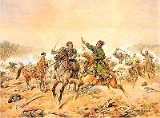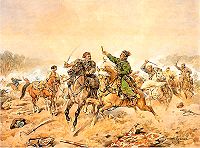
Jan Chryzostom Pasek
Encyclopedia
| Jan Chryzostom Pasek | |
EWLINE |
|
| Jan Chryzostom Pasek in Battle of Lachowicze, 1660 by Juliusz Kossak Juliusz Kossak Juliusz Fortunat Kossak was a Polish historical painter and master illustrator who specialized in battle scenes, military portraits and horses... (1824-1899) |
|
| Noble Family Szlachta The szlachta was a legally privileged noble class with origins in the Kingdom of Poland. It gained considerable institutional privileges during the 1333-1370 reign of Casimir the Great. In 1413, following a series of tentative personal unions between the Grand Duchy of Lithuania and the Kingdom of... |
Pasek Pasek Pasek is the surname of:* Andrzej Pasek, Polish 52nd place in Mixed individual eventing, 2004 Summer Olympics* Jan Chryzostom Pasek, szlachcic of Polish-Lithuanian Commonwealth in 17th century... |
| Coat of Arms Polish heraldry Polish heraldry is a branch of heraldry focused on studying the development of coats of arms in the lands of historical Poland , as well as specifically-Polish traits of heraldry. The term is also used to refer to Polish heraldic system, as opposed to systems used elsewhere, notably in Western Europe... |
Doliwa |
| Parents | ? |
| Consorts | unknown |
| Children | none |
| Date of Birth | about 1636 |
| Place of Birth | Węgrzynowice Wegrzynowice Węgrzynowice is a village in the administrative district of Gmina Budziszewice, within Tomaszów Mazowiecki County, Łódź Voivodeship, in central Poland... |
| Date of Death | 1 August 1701 |
| Place of Death | Niedzieliszki |
Jan Chryzostom Pasek (about 1636–1701) was a Polish nobleman (szlachcic) and writer in the Polish-Lithuanian Commonwealth
Polish-Lithuanian Commonwealth
The Polish–Lithuanian Commonwealth was a dualistic state of Poland and Lithuania ruled by a common monarch. It was the largest and one of the most populous countries of 16th- and 17th‑century Europe with some and a multi-ethnic population of 11 million at its peak in the early 17th century...
. He is best remembered for his memoirs (Pamietniki), which are a valuable historical source about Baroque
Baroque
The Baroque is a period and the style that used exaggerated motion and clear, easily interpreted detail to produce drama, tension, exuberance, and grandeur in sculpture, painting, literature, dance, and music...
sarmatian
Sarmatism
"Sarmatism" is a term designating the dominant lifestyle, culture and ideology of the szlachta of the Polish-Lithuanian Commonwealth from the 16th to the 19th centuries. Together with "Golden Liberty," it formed a central aspect of the Commonwealth's culture...
culture and events in the Polish-Lithuanian Commonwealth.
Born in Węgrzynowice near Rawa Mazowiecka
Rawa Mazowiecka
Rawa Mazowiecka is a town in central Poland, with 17,765 inhabitants . It lies in the Łódź Voivodeship and is the capital of Rawa County.First mentioned in 1288, it received city rights in 1321....
in 1636, into a minor szlachta
Szlachta
The szlachta was a legally privileged noble class with origins in the Kingdom of Poland. It gained considerable institutional privileges during the 1333-1370 reign of Casimir the Great. In 1413, following a series of tentative personal unions between the Grand Duchy of Lithuania and the Kingdom of...
family, he attended a Jesuit school. Pasek enlisted in the army at age 19 and for 11 years he was a soldier in a Polish military, where he fought in the campaigns under hetman
Hetman
Hetman was the title of the second-highest military commander in 15th- to 18th-century Poland and the Grand Duchy of Lithuania, which together, from 1569 to 1795, comprised the Polish-Lithuanian Commonwealth, or Rzeczpospolita....
Stefan Czarniecki
Stefan Czarniecki
Stefan Czarniecki or Stefan Łodzia de Czarnca Czarniecki Polish-Lithuanian Commonwealth general and nobleman. Field Hetman of the Crown of the Polish Kingdom. He was a military commander, regarded as a Polish national hero...
against Sweden
Sweden
Sweden , officially the Kingdom of Sweden , is a Nordic country on the Scandinavian Peninsula in Northern Europe. Sweden borders with Norway and Finland and is connected to Denmark by a bridge-tunnel across the Öresund....
, in the Denmark
Denmark
Denmark is a Scandinavian country in Northern Europe. The countries of Denmark and Greenland, as well as the Faroe Islands, constitute the Kingdom of Denmark . It is the southernmost of the Nordic countries, southwest of Sweden and south of Norway, and bordered to the south by Germany. Denmark...
campaign, took part in the war and negotiations with Moscow (where he was member of the diplomatic mission
Diplomatic mission
A diplomatic mission is a group of people from one state or an international inter-governmental organisation present in another state to represent the sending state/organisation in the receiving state...
), fought the rokoszans of Lubomirski
Lubomirski's Rokosz
Lubomirski's Rokosz, or Lubomirski's Rebellion , was a rebellion against Polish King Jan II Kazimierz Vasa, initiated by the Polish nobleman, Jerzy Sebastian Lubomirski.In 1665-66, Lubomirski's supporters paralyzed the proceedings of the Sejm...
and Turks. In 1667 he married and retired to his estate in Małopolska (south Poland). Lawsuits that arose from his various excesses and conflicts with neighbours eventually resulted in his sentence to exile, but the sentence was never enforced.
Literary output
Near the end of his life (likely around 1690-1695) Pasek wrote an autobiographical diary, a copy of which was found in 18th century and printed in 1821, making him posthumously famous. In his memoirs, he depicts in vivid language the everyday life of szlachcic, both during wartime and peace, with valuable batallistic scenes. He relates the tales of the 17th-century Swedish and Muscovite wars, the catastrophic last years of the reign of King John II Casimir (1648-68), the incompetent rule of King Michał Korybut Wiśniowiecki (1669-73), and he concludes his narrative with the splendid reign of King Jan III SobieskiJohn III Sobieski
John III Sobieski was one of the most notable monarchs of the Polish–Lithuanian Commonwealth, from 1674 until his death King of Poland and Grand Duke of Lithuania. Sobieski's 22-year-reign was marked by a period of the Commonwealth's stabilization, much needed after the turmoil of the Deluge and...
(1674-96). In the first part of the diary (1656 - 66), Pasek depicts the military life, showing soldiers primary motivations, like curiosity, desire of fame and loot, and disregard for deep religious messages. In describing peacetime life (1667-88), he sees nothing wrong with serfdom
Serfdom
Serfdom is the status of peasants under feudalism, specifically relating to Manorialism. It was a condition of bondage or modified slavery which developed primarily during the High Middle Ages in Europe and lasted to the mid-19th century...
and peasant
Peasant
A peasant is an agricultural worker who generally tend to be poor and homeless-Etymology:The word is derived from 15th century French païsant meaning one from the pays, or countryside, ultimately from the Latin pagus, or outlying administrative district.- Position in society :Peasants typically...
social class
Social class
Social classes are economic or cultural arrangements of groups in society. Class is an essential object of analysis for sociologists, political scientists, economists, anthropologists and social historians. In the social sciences, social class is often discussed in terms of 'social stratification'...
oppression. Representing late sarmatism culture, he views only szlachta social class as the only real representative of Poland. Pasek died on 1 August 1701 in Niedzieliszki village.
External Links
- Pasek's Otter at the Wilanów Palace Museum

